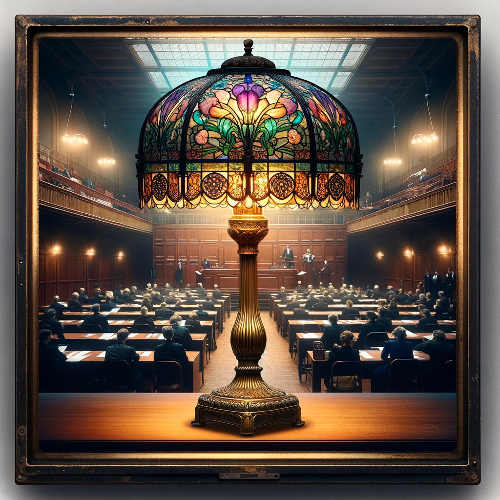Art Nouveau, an art movement that flourished in the late 19th and early 20th centuries, is known for its sinuous lines, nature-inspired patterns, and fluid aesthetics. The Antique Art Nouveau lamps perfectly embody this period of creativity and innovation. Whether it is a Gallé lamp, a Tiffany style lamp or a Art Nouveau bronze lamp, these lights are works of art that illuminate not only our interiors, but also our imagination. In this article, we'll explore the history, features, and importance of Art Nouveau lamps, as well as tips for incorporating them into modern décor.
The History of Art Nouveau and Lighting
The Art Nouveau movement emerged in the late 19th century as a reaction to the academic and industrial styles of the time. It is characterized by a direct inspiration from nature, with organic shapes, curved lines and floral patterns. The Art Nouveau lamps are perfect examples of this aesthetic, often using materials such as glass, bronze, and brass to create unique and captivating pieces.
One Old Art Nouveau lamp is often considered a collector's item, with designs influenced by renowned artists and designers like Émile Gallé and Louis Comfort Tiffany. Gallé lamps, for example, are famous for their etched glass shades and delicate floral patterns. Similarly, the Tiffany style lamps are renowned for their colorful stained glass windows and intricate metal structures.
Discover Art Nouveau Lamps

The Antique Art Nouveau lamps are distinguished by several unique features. First of all, the materials used are often natural and of high quality. Glass, in particular, plays a central role in the design of these lamps. The Gallé lamps use engraved and painted glass to create floral and organic patterns, while Tiffany Art Nouveau lamps are known for their multicolored stained glass windows.
Bronze is another commonly used material, especially for lamp bases and structures. One Art Nouveau bronze lamp is not only durable but also rich in detail, often adorned with floral or animal motifs. This material adds a touch of luxury and sophistication to the lamp, while showcasing the meticulous craftsmanship of the time.
The forms of the Art Nouveau lamps are generally fluid and organic, inspired by nature. Curved lines and asymmetrical patterns are common, reflecting an aesthetic that seeks to mimic natural forms rather than rigid, geometric structures.
The Art Nouveau Lamp: A decorative element
Integrate a Old Art Nouveau lamp in a modern interior can bring a touch of elegance and timeless charm. Here are some tips for a successful integration:
Contrast and Harmony : Pair Art Nouveau lamps with modern furniture to create an interesting visual contrast. For example, a Art Nouveau lamp Gallé can be placed on a contemporary desk for a striking effect.
Focal Points : Use Art Nouveau lamps as focal points in a room. Their unique design and intricate details naturally attract attention and can serve as a centerpiece.
Natural Themes : Complete the Art Nouveau lamps with other decorative elements inspired by nature. Plants, floral-patterned textiles, and wooden furniture can enhance the lamp's organic aesthetic.
Gallé and Tiffany Lamps: Illuminated Works of Art
The Gallé lamps and Tiffany Art Nouveau lamps are among the most sought-after of the Art Nouveau collections. Gallé lamps, created by Émile Gallé, are renowned for their engraved and enamelled glass, often decorated with motifs of flowers, leaves and insects. Each piece is unique, reflecting the expertise and inspiration of its creator.
The Tiffany style lamps, meanwhile, are famous for their colorful stained glass shades, designed by Louis Comfort Tiffany. These lamps use multicolored pieces of glass assembled to create intricate and vibrant patterns. The Tiffany Art Nouveau lamps are often considered centerpieces in a collection, thanks to their dazzling beauty and exceptional craftsmanship.
Art Nouveau Bronze Lamps: Elegance and Durability
Bronze is a material that perfectly embodies the spirit of Art Nouveau. Used for the bases and structures of the lamps, it offers both durability and refinement. One Art Nouveau bronze lamp can feature carved motifs, creeper shapes, or animal figures, adding an extra artistic dimension.
These bronze lamps are often paired with glass shades, creating a harmonious contrast between the strength of metal and the delicacy of glass. Their imposing presence and refined details make them ideal pieces to bring a touch of sophistication to any room.
Comparison with Art Deco Lamps
Although Art Nouveau and Art Deco are two distinct movements, they share a passion for elegant design and quality materials. One Art Deco lamp 1930 stands out for its geometric lines and more industrial aesthetic, contrasting with the organic shapes and natural patterns of Art Nouveau.
Incorporating elements of both styles can create an eclectic and sophisticated interior. For example, a Old Art Nouveau lamp can be placed next to a Art Deco lamp 1930 to juxtapose the two styles and enrich the atmosphere of the room.
Antique Table Lamps
The antique desk lamps, whether in Art Nouveau or Art Deco style, bring a touch of elegance to a workspace. One Old Art Nouveau lamp on a modern desk creates an interesting contrast, while providing a functional light source. The antique desk lamps are often equipped with articulated arms or adjustable heads, allowing for flexible and convenient use.
Conclusion
The Antique Art Nouveau lamps are not just sources of light, but works of art that capture the essence of an era rich in creativity and innovation. Whether it is a Gallé lamp, a Tiffany style lamp or a Art Nouveau bronze lamp, each piece brings a touch of elegance and sophistication to any interior.
By incorporating these fixtures into your décor, you can not only enhance the lighting in your space, but also add a touch of refinement and character. The Art Nouveau lamps are timeless treasures that continue to captivate and inspire design lovers across generations.

